Petrol has evolved significantly in the past few decades. While traditional fuels used to be simple hydrocarbon blends, today’s petrol often contains ethanol—a bio-based additive designed to reduce emissions and reliance on fossil fuels. While this has its environmental advantages, ethanol in fuel can sometimes cause problems for engines, particularly in older vehicles, motorcycles, boats, and small equipment. That’s where the question of how to remove ethanol from petrol comes in.
In this detailed guide, we’ll explore the benefits and drawbacks of ethanol blends, the methods of removing ethanol from petrol, and the safest practices for those who prefer to use non ethanol gas or ethanol free petrol.
Understanding Ethanol in Petrol
Ethanol is an alcohol derived from renewable resources such as corn or sugarcane. It is commonly blended with petrol to create fuel mixtures like petrol 10 ethanol (also known as E10). This means the fuel contains 10% ethanol and 90% petrol.
Why Ethanol Is Used
- Environmental Benefits – Reduces greenhouse gas emissions.
- Octane Boost – Increases fuel’s octane rating, improving combustion.
- Renewable Source – Decreases dependence on crude oil.
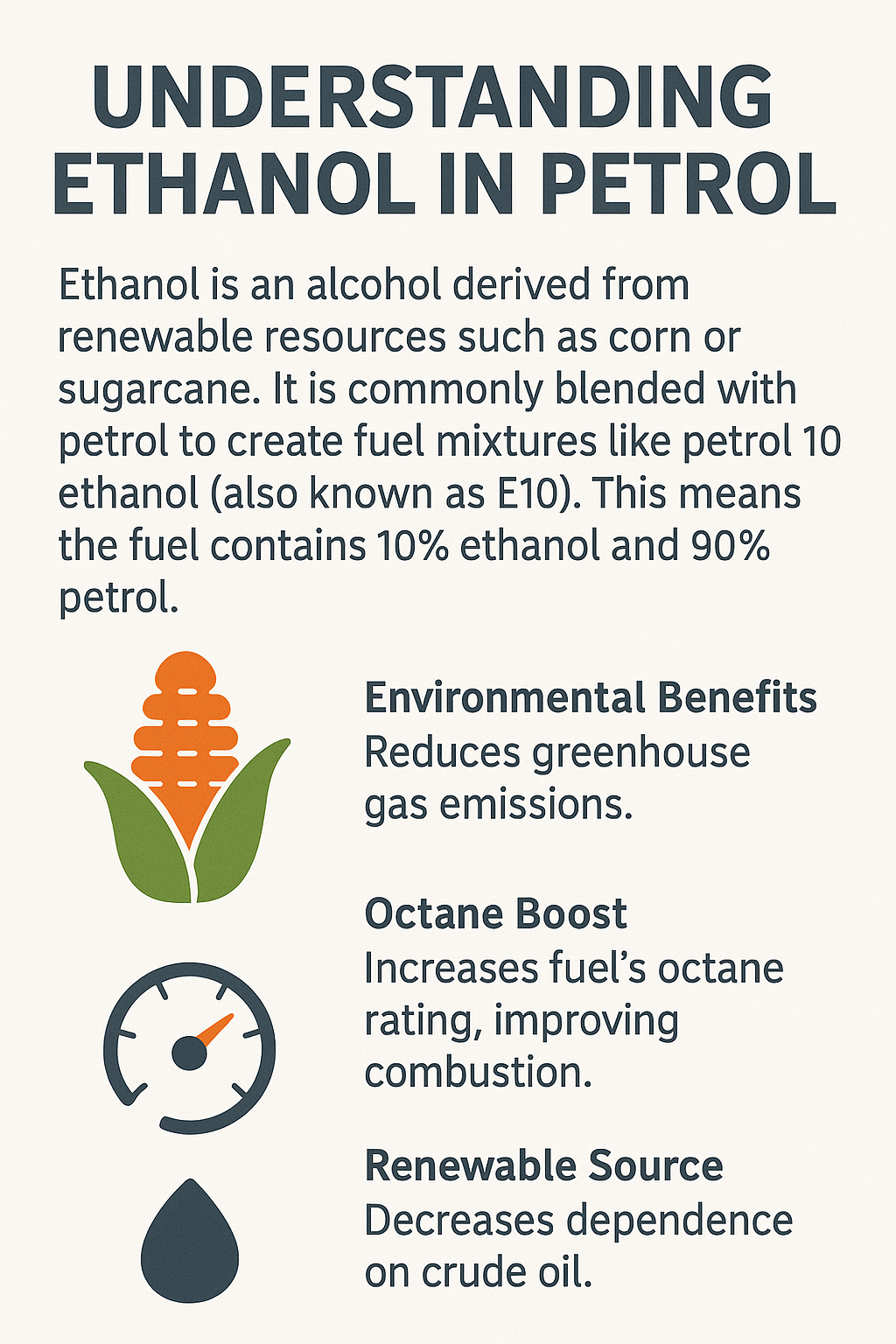
The Drawbacks of Ethanol in Petrol
- Moisture Absorption – Ethanol attracts water, which can lead to corrosion.
- Reduced Efficiency – Vehicles often get lower mileage compared to non ethanol petrol.
- Engine Damage in Older Vehicles – Carbureted engines and older fuel systems may struggle with ethanol.
- Storage Issues – Ethanol-blended petrol has a shorter shelf life, making it unsuitable for long-term storage in boats or backup generators.
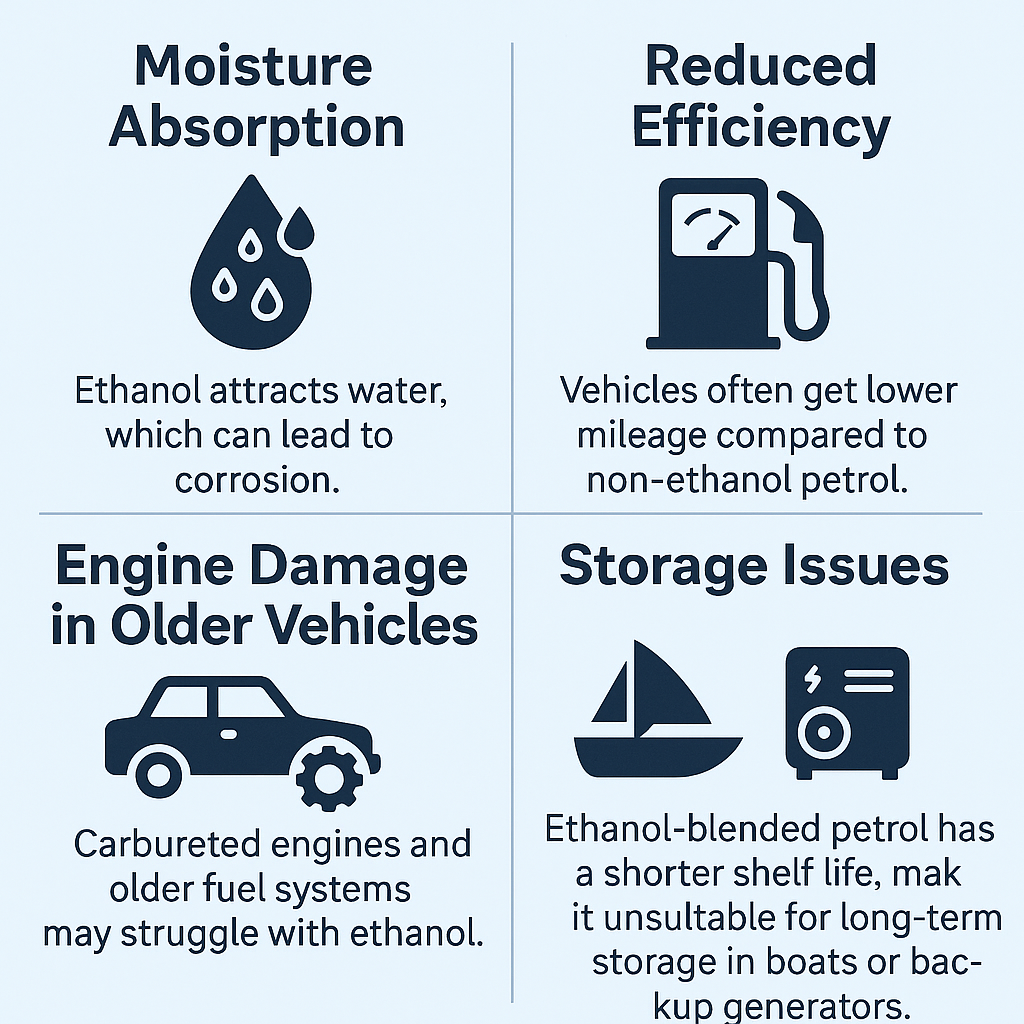
Why People Prefer Ethanol Free Petrol
Many drivers seek out ethanol free petrol or non ethanol gas because of its stability and efficiency. Classic car owners, boat enthusiasts, and small equipment users especially prefer it, as ethanol can cause costly maintenance issues in these types of engines.
Although the ethanol petrol price is often lower due to subsidies and availability, many drivers still choose to pay extra for non ethanol petrol because it extends engine life, ensures smoother performance, and avoids storage complications.
How to Remove Ethanol from Petrol
Now let’s look at the practical question: how to remove ethanol from petrol if you don’t have access to non ethanol gas. While possible, this process must be done carefully and safely.
Step 1: Understand the Process
Ethanol is soluble in water, which means it can be separated from petrol through a water absorption process. When water is added to ethanol-blended petrol, the ethanol bonds with the water and separates out from the petrol.
Step 2: Gather Supplies
- A clean, transparent container (preferably glass or a fuel-safe plastic jug).
- Water (distilled water is recommended for purity).
- A siphon or fuel-safe pump.
- Protective gloves and eyewear for safety.
Step 3: Mix Petrol and Water
- Pour the petrol 10 ethanol into the container.
- Add about 10% water relative to the amount of petrol (e.g., 1 liter of water for 10 liters of petrol).
- Shake gently to ensure mixing.
Step 4: Allow Separation
- Let the mixture sit undisturbed for a few hours.
- The ethanol will bond with the water and settle at the bottom, creating a visible separation between the petrol and the ethanol-water mixture.
Step 5: Extract the Petrol
- Carefully siphon or pour the top layer of non ethanol petrol into another clean container.
- Discard the ethanol-water mixture responsibly—never pour it down drains or into the ground.
Safety Considerations
While removing ethanol from petrol is possible, it carries risks. Petrol is highly flammable, and improper handling can cause accidents. Here are some precautions:
- Do It Outdoors – Always work in a well-ventilated space, away from sparks and flames.
- Wear Protection – Gloves, safety glasses, and proper clothing are essential.
- Use Correct Containers – Only use fuel-rated, sealed containers.
- Dispose Safely – Follow local hazardous waste disposal rules for the ethanol-water byproduct.
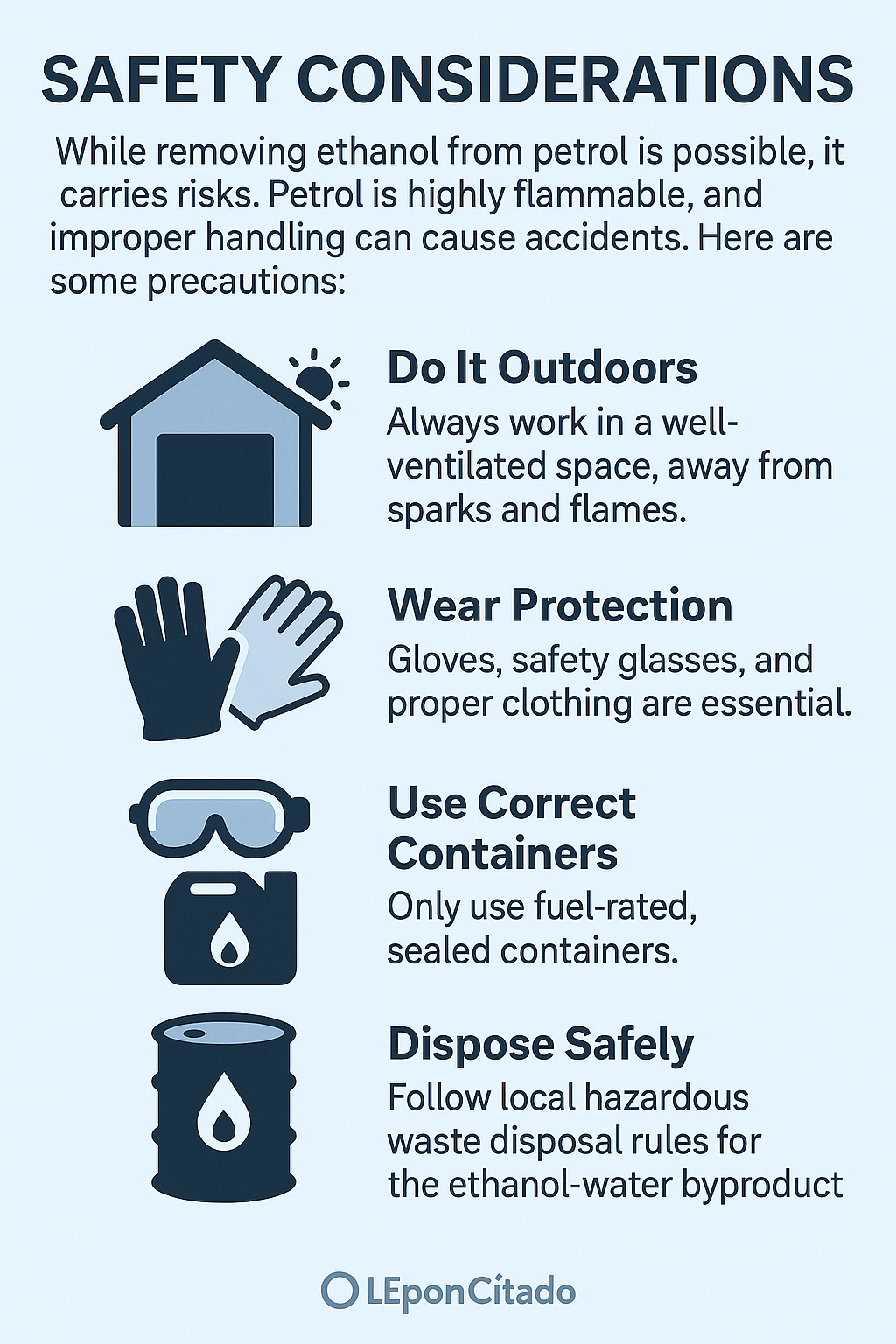
Drawbacks of Removing Ethanol from Petrol
Although the process works, it’s not without drawbacks:
- Volume Loss – You’ll lose some usable petrol because the ethanol and water mixture takes away part of the fuel.
- Octane Reduction – Ethanol boosts fuel’s octane rating. Removing it may lower performance.
- Time-Consuming – The process requires patience and careful handling.
Because of these drawbacks, many experts recommend buying ethanol free petrol directly rather than attempting to remove ethanol yourself.
Cost Comparison: Ethanol Petrol Price vs Non Ethanol Gas
- Ethanol Petrol Price – Typically cheaper because ethanol is subsidized and widely available.
- Non Ethanol Petrol Price – Usually higher due to limited supply and niche demand.
However, when you factor in the potential for better mileage, reduced maintenance costs, and longer engine life, the total ownership cost of non ethanol petrol may actually balance out over time.
Alternative Options
If you can’t access non ethanol gas or don’t want to attempt removing ethanol from petrol, consider these alternatives:
- Fuel Stabilizers – Additives designed to counteract ethanol’s negative effects.
- Blended Use – Use ethanol blends for everyday driving but switch to non ethanol petrol for seasonal equipment like boats or generators.
- Seek Local Suppliers – Some stations specialize in ethanol free petrol. Online directories can help locate them
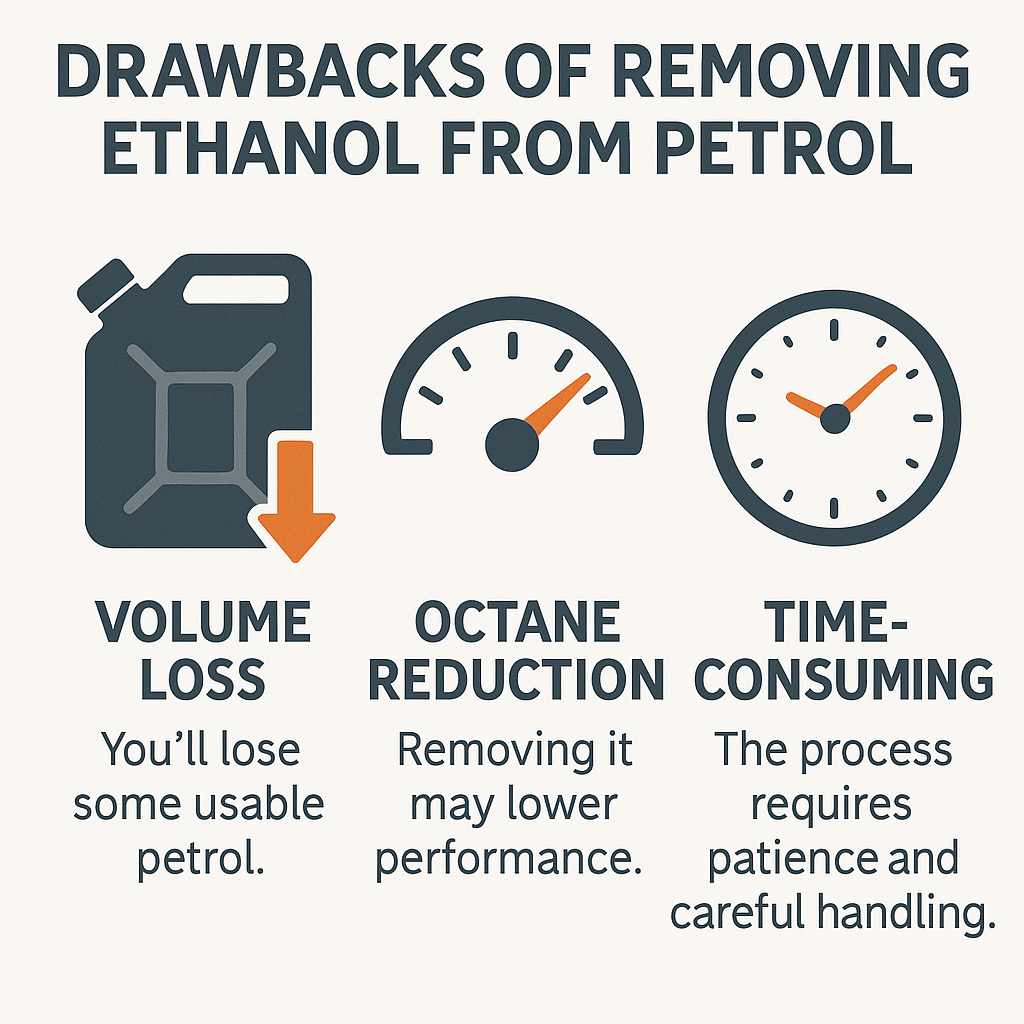
Final Thoughts
Learning how to remove ethanol from petrol can be useful knowledge, but it’s not always the most practical solution. While the method works, it comes with risks, potential loss of fuel quality, and extra effort.
For most drivers, the better choice is to purchase non ethanol petrol directly when available, especially for vehicles or equipment sensitive to ethanol. While the ethanol petrol price may be lower for E10 blends, the long-term savings in maintenance, efficiency, and reliability often make non ethanol gas the smarter investment.
At nexgenwheels, we believe that understanding your fuel choices is key to protecting both your vehicle and your wallet. Ultimately, the decision comes down to your specific needs. Whether you opt for non ethanol petrol or choose to work with petrol 10 ethanol, knowing the pros and cons empowers you to make the right choice for your vehicle and lifestyle.

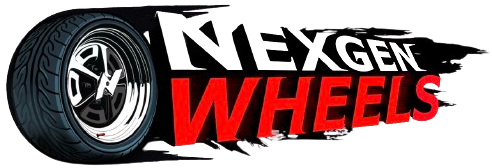
2 Comments
Your blog is a testament to your dedication to your craft. Your commitment to excellence is evident in every aspect of your writing. Thank you for being such a positive influence in the online community.
Thank you for the auspicious writeup It in fact was a amusement account it Look advanced to more added agreeable from you By the way how could we communicate